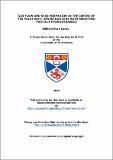Gas flow and star formation in the centre of the Milky Way : investigations with smoothed particle hydrodynamics
Abstract
The centre of the Milky Way, commonly referred to as the Galactic Centre, is roughly that region within 500 pc of the central black hole, Sagittarius A*. Within the innermost parsec around the supermassive black hole Sagittarius A* are more than a hundred massive young stars whose orbits align to form one or possibly two discs. At about 100 pc is a ring containing more than ten million solar masses of molecular gas which could be the origin of some of the most massive star clusters in the Galaxy. I have performed a number of numerical simulations to help us understand how it is that these structures may have been formed.
I firstly describe and test an improvement to the smoothed particle hydrodynamics code I used. This improves conservation of energy and momentum in certain situations such as in strong shocks from supernovae, which were to be included in a later chapter.
The discs of massive stars around Sagittarius A* are believed to have been born there within fragmenting gaseous discs. This is problematic, as the formation of two stellar discs would require two gaseous counterparts. A method is described of forming multiple discs around a black hole from a single cloud’s infall and subsequent tidal destruction. This is due to its prolate shape providing a naturally large distribution in the direction of the angular momentum vectors within the cloud. The resulting discs may then go on to form stars.
Energetically, it would appear that a sequence of supernovae could potentially cause a giant molecular cloud to fall inwards towards the central black hole from an originally large orbit around the Galactic Centre. I simulate the impact on a giant molecular cloud of supernovae originating from a massive stellar cluster located a parsec away. Ultimately, the supernovae are found to have little effect.
Finally, I simulate the formation of the dense ring of clouds observed in the Central Molec- ular Zone at a distance of about 100 pc from Sgr A*. Infalling gas is shown to be subject to such extreme tidal forces that a single cloud of gas is extended to form a long stream. The ribbon grows to the point that it self-intersects and forms a ring-like structure. Its complexity depends on the orbit of the original cloud. The position-velocity data is compared with observations, and similarities are noted.
Type
Thesis, PhD Doctor of Philosophy
Collections
Description of related resources
Lucas, WE, Bonnell, IA, Davies, MB, & Rice, WKM, 2013, MNRAS, 433, 353 (doi:10.1093/mnras/stt727)Items in the St Andrews Research Repository are protected by copyright, with all rights reserved, unless otherwise indicated.

